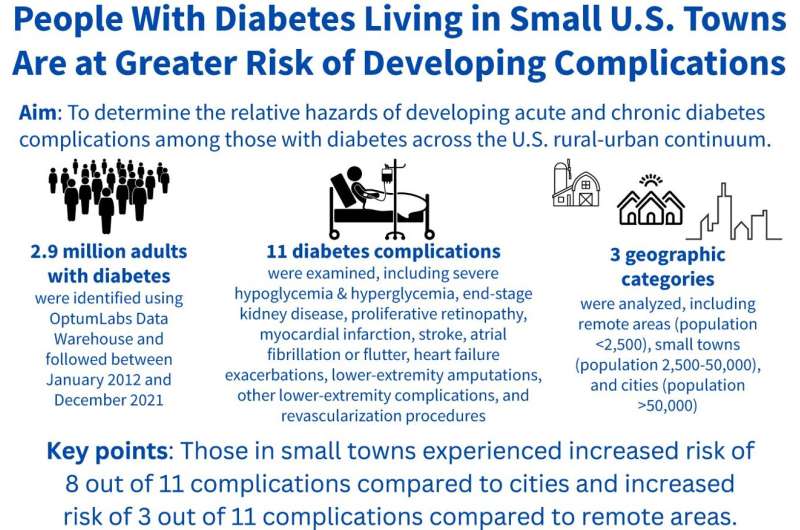This article has been reviewed according to Science X's editorial process and policies. Editors have highlighted the following attributes while ensuring the content's credibility:
fact-checked
trusted source
proofread
People with diabetes who live in rural areas more likely to develop complications of the disease, study finds

It has been well established that people who live in rural areas in the U.S. are more likely to have diabetes and experience barriers to managing their condition compared to those who live in the suburbs and cities. Now, University of Maryland School of Medicine researchers have measured the devastating toll of this health disparity.
Those who live in small towns experience a significantly higher risk of eight complications related to diabetes—including heart attacks and kidney disease—failure compared to those who live in well-populated suburbs and cities, according to a new study published in the journal Diabetes Care.
The study analyzed health insurance data from nearly 3 million adults with diabetes across the U.S. over a 10-year period through 2021. They found that those living in small towns (population size of 2,500 to 50,000 people) were 10 percent more likely to experience a heart attack, 5 percent more likely to heart failure, and about 4 percent more likely to have end-stage kidney disease compared to those living in larger towns and cities.
"Those who live in rural areas have a greater risk of experiencing 8 out of the 11 complications that we measured compared with those living in cities," said study corresponding author Rozalina McCoy, MD, Associate Professor of Medicine at UMSOM and Director of the Precision Medicine and Population Health Program at the University of Maryland Institute for Health Computing.
"They were 15 percent more likely to have dangerously low blood sugar levels, which clearly indicates that their diabetes is not being managed properly."
About 14 percent of those in the study lived in small towns, compared to 83 percent who lived in cities. An additional 3 percent lived in remote areas of fewer than 2,500 people living within a defined geographic area in their county.
"While our study didn't address why these differences exist, we do know that people living outside of city areas are less likely to receive care from diabetes specialists, to receive diabetes self-management education, and to be monitored for diabetes complications," said study co-author Esa Davis, MD, Professor of Family & Community Medicine and Senior Associate Dean for Population and Community Medicine at UMSOM.
"Our research builds on this foundational evidence to demonstrate a possible impact that these differences have on preventable diabetes complications."
Interestingly, the study found that people living in remote areas had lower risks of being diagnosed with some diabetes complications. They were 15 percent less likely to have dangerously high blood sugar levels and were 6 percent less likely to experience heart failure compared to those living in small towns.
But that may not mean they are actually having fewer complications: Since the study team relied on insurance information to identify diabetes complications, if people were not able to access medical care, that complication would not be captured.
Dr. McCoy noted that this finding further underscored the barriers to care in remote areas: patients are likely having high blood sugar emergencies and heart failure but cannot get to the emergency department or hospital to have them diagnosed and treated.
The researchers controlled for age, sex, health insurance type, diabetes type, medication use, and chronic health conditions.
"While the relative risk increases in diabetes complications were modest for those who dwell in rural areas, they can add up to a huge health burden since more than 5 million Americans who have diabetes live in small towns," said Mark T. Gladwin, MD, who is the John Z. and Akiko K. Bowers Distinguished Professor and Dean of UMSOM, and Vice President for Medical Affairs at University of Maryland, Baltimore.
"There is a pressing need to enhance physician and medical provider services and hospital services for those living in rural communities, and we are planning a new program to bring our medical students to Maryland's rural Eastern Shore to help address this disparity."
More information: Kyle Steiger et al, Disparities in Acute and Chronic Complications of Diabetes Along the U.S. Rural-Urban Continuum, Diabetes Care (2024). DOI: 10.2337/dc23-1552





















